The City of Austin amended its Code to ban the use and sale of pavement sealants with more than .1% (1000 ppm) PAH by weight within the City’s planning jurisdiction (full purpose city limits and ETJ). The one exception is that the sealant may be sold if the intended application area is outside the City’s ETJ. The Austin ban was effective January 1, 2006 and was amended October 17, 2019 to expand the prohibition from coal tar to high Polycyclic Aromatic Hydrocarbons (PAH) sealants.
PAH’s are a group of chemicals formed during the incomplete burning of coal, gasoline, wood, garbage or other organic substances such as tobacco, charcoal broiled meat, and incense. As a pollutant, they are of concern because some compounds have been identified as cancer-causing. For example, one PAH compound, benzo[a]pyrene, is notable for being one of the first chemical carcinogens discovered; one of many found in cigarette smoke. PAHs are lipophilic (mix more easily with oil than water). The larger compounds are less water-soluble and less volatile (less prone to evaporate). Therefore, PAHs in the environment are found primarily in soil, sediment and oil substances, as opposed to water or air. However, they can be found in particulate matter suspended in air.
High PAH sealants may contain coal tar, coal tar pitch volatiles, RT-12, refined tar, steam-cracked petroleum residues, heavy pyrolysis oil, steam-cracked asphalt, pyrolysis fuel oil, heavy fuel oil, ethylene tar, ethylene cracker residue, or a variation of those substances assigned the chemical abstracts service (CAS) numbers 65996-92-1, 65996-93-2, 65996-89-6, 8007-45-2, 64742-90-1, or 69013-21-4; and is for use on an asphalt or concrete surface, including a driveway, playground, or parking area.
Basis for the Ban
- PAHs are a high-profile pollutant of growing concern nationwide, due to increasing concentrations in waterways
- The ban provides an unprecedented opportunity to eliminate a significant pollutant threat to our local water resources
- The combination of chemical tracing, laboratory toxicity, and field-verified degradation provides ample evidence to support regulatory action to remove the use of high PAH sealants within the City’s jurisdiction.
During our annual surveys of stream sediment chemistry, concentrations of Total PAHs (the sum of 16 compounds) generally range from <1mg/kg to over 200 over the past 15 years (Fig. 1). A screening value of 23 mg/kg is used as a threshold, above which, aquatic life use is expected to be negatively effected (Probably Effects Concentration, or PEC), and most of our data falls below this value. However there are a number of locations that have exceeded this value one or more times, and we are looking at these sites carefully for temporal trends and potential best practices that will address the source of PAHs to these sites.
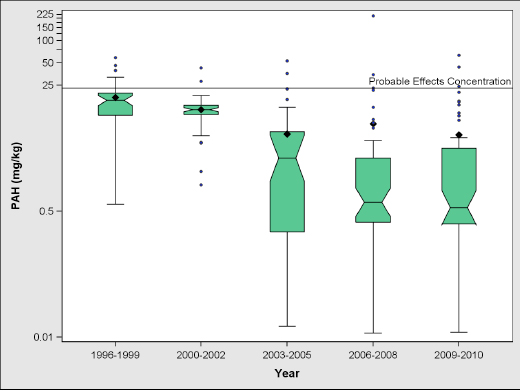
Figure 1: Box plot of total PAH (mg/Kg) collected in EII sampling from 1996-2010. Black diamonds represent means, notched lines represent medians, and small circles represent outliers.
By removing this potent source of PAHs to our environment, we are reducing PAHs in our streams. A United States Geological Survey (USGS) study conducted in 2014 showed a 58% reduction in PAH’s in lake sediment from Lady Bird Lake.
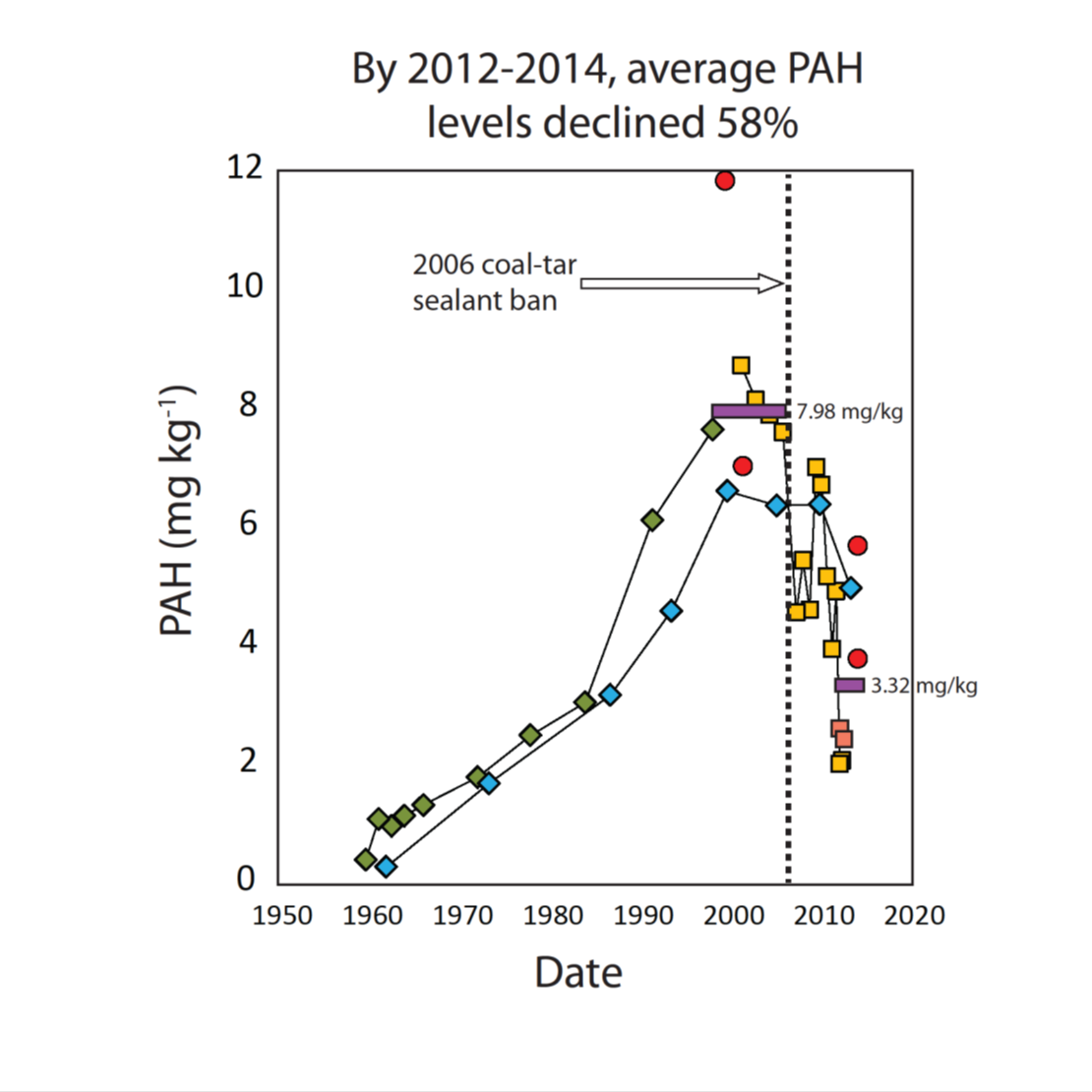
Vehicle tires abrade parking lot sealcoat into small particles. These small particles are washed off parking lots by precipitation and into storm sewers and streams. Sealcoat “wear and tear” is visible in high traffic areas within a few months after application. Sealcoat manufacturers recommend reapplication every 2 to 3 years.
Besides urban runoff as a pathway, PAH can originate from atmospheric fallout of particulates from naturally occurring combustion sources like forest fires or from fossil fuel combustion - incomplete burning of carbon-containing materials like oil, wood, garbage, and coal. Automobile exhaust and industrial emissions are additional sources. They contain high levels of PAHs. More PAHs form when materials burn at low temperatures such as in wood fires and cigarettes than in high-temperature furnaces.
Many useful products such as mothballs, blacktop, and creosote wood preservatives contain PAHs. They are also found at low concentrations in some special purpose skin creams and anti-dandruff shampoos that contain coal tars.
Field staff for the Watershed Protection Department watch for sealant applications in progress and freshly sealed parking lots as they drive throughout the city on their other job duties. Newly applied sealants are screened for the presence of high PAHs. Enforcement action is taken when high PAH pavement sealant is found to be applied after the ban was initiated. Enforcement action through municipal court typically involves remediation of the applied sealant. The requirement for remediation is full removal of the applied sealant and fines.
The city produces and disseminates educational materials to producers, applicators, buyers, and to the general public through various means. City staff also periodically checks distributors to monitor product on their shelves.
Citizens may call in suspected high PAH applications to the City’s 24-Hour Pollution Hotline at 512-974-2550.
The detrimental effects of PAHs aquatic ecosystems are well documented. Examples:
- Fish - When fish are exposed to PAHs, they exhibit chronic problems, including fin erosion, liver abnormalities, cataracts, skin tumors, and immune system impairments leading to increased susceptibility to disease.
- Benthic macroinvertebrates - When benthic macroinvertebrates, insects and other organisms that live at the bottom of rivers and lakes and that make up the base of the aquatic food chain, are exposed to PAHs, they are susceptible to a number of detrimental effects, including inhibited reproduction, delayed emergence, sediment avoidance, and mortality. The most important mechanism by which acute effects occur in benthic invertebrates is a nonspecific narcosis-like mode of action that results in the degradation of cell membranes. Ultraviolet (UV) radiation greatly increases the toxicity of PAHs in a wide variety of aquatic organisms.
The City of Austin has conducted a range of laboratory and field experiments which documented the negative effect that PAHs from coal tar sealants have on benthic invertebrates that live in our streams. This work was a primary support and motivator for the ban of coal tar sealants in Austin
The City of Austin continually seeks ways to educate producers, applicators, buyers and the general public about high PAH sealants. City of Austin staff:
- Meet with applicators and producers
- Host public meetings with citizens
- Send regulatory and educational mail outs to producers, applicators, apartments, churches, public and private schools, rental car companies, large hardware stores, large food chains, large retailers, management companies, etc.
- Publish scientific papers
- Benchmark data and information with other cities
- Respond to requests for information from citizens and the media
- Create outreach pieces like: Ads in utility bill inserts, brochures, handouts, flyers
Sealants containing high levels of PAH should not be disposed of as regular garbage. Austin and Travis County residents may dispose of small quantities of these based products at the City of Austin’s Facility Recycle and Reuse Drop-Off Center. The facility is located at 2514 Business Center Drive and is open on Tuesdays and Wednesdays from noon to 7 p.m. Businesses requiring information regarding the disposal of coal tar based products may call 512-974-3443.
If you have specific questions concerning the regulations governing the disposal of high PAH wastes, please contact the Municipal Solid Waste Permits Section of the Texas Commission on Environmental Quality at (512) 239-2334.
When a violation of the ordinance occurs, the City of Austin requires removal of the coal tar sealant. One of the most effective ways to meet this requirement is by a process called ‘shot-blasting’. Shot-blasting uses small steel beads or “shot”, and a blasting machine, to remove the top layer or layers of sealant. Blasting machines come in two different styles, walk behind (self-propelled or push) and ride-on, with varying blasting widths ranging from 8” to 48”.
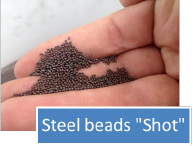
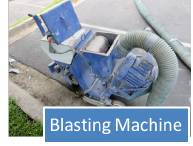
The City of Austin requires that shot-blasting machines have a dust collection system (bag or cartridge filters) that minimizes or eliminates air-born dust particles containing harmful PAH’s from contaminating nearby soils, lakes or streams. The removed sealant should be properly contained on the site. Depending on the size of the removal project, some containment options may be bagging the waste in heavy-duty black trash bags or using a roll-off dumpster. Roll-off dumpsters should be properly covered with tarps or plastic sheeting to prevent runoff should precipitation occur. Once the project is completed the generated coal tar waste should be properly disposed of (See “Coal PAH Disposal” under the FAQ section)
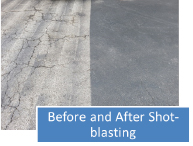
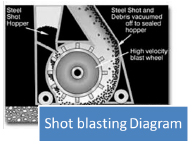
Property and business owners should ensure that their contractor is properly licensed and bonded and will use the correct removal and disposal methods.
Listed below are contractors known to provide shot-blasting services for the removal of coal tar-based sealants. There may be other contractors that can perform the work. Contractors that are interested in being added to this list may email Christopher Miller to begin the process.
|
Name |
Contact |
Phone |
|
Paul Jackson |
405-495-9797 |
|
|
Chris Johnson |
972-881-0391 |
|
|
281-350-3663 |
This list is compiled from various listings and company contacts and may not represent all shot-blasting companies that service the Austin area. The Watershed Protection Department does not endorse company products or services and is not responsible for their performance.
Considering Seal Coating your Parking Lot?
The following recommendations will assist you in getting a better job that lasts longer while protecting the environment
Choose the Right Applicator
- Learn about the company and their track record. Ask the applicator for references and contact the Better Business Bureau or Chamber of Commerce to see if complaints have been lodged against the contractor. Take a few hours and visit some properties that the sealant company has done. Be sure and include a site that is more than a year old.
- Always ask the applicator what warranty is offered with the product and the workmanship. Often products are given a manufacturer’s warranty that may convey to the property owner when applied correctly. Get the warranty in writing before the start of work.
- Sealants come in a variety of packages and product names. Several producers require applicators be trained to apply their product, take a few minutes and inquire as to the applicators expertise.
- Get a written contract or agreement for the work.
Choose the Right Product
- Research the sealant to be used, how long it is likely to last and how it is made. Remember that sealants containing more than .1% PAH by weight are banned in Austin and its ETJ. Check the Safety Data Sheet (SDS) for information on the sealant ingredients. The company sealing your lot should have the SDS available. Click here for a list of approved products.
- If you have old PAH sealant present, consider having it removed prior to re-sealing. Equipment is available in Texas which can remove sealant with a shot blasting process. It can be done if dust is controlled and the removed sealant is disposed of in the trash. This eliminates the possibility of future coal tar pollution from old degrading sealant.
- Consider using a lighter colored sealant. Lighter colored sealant will often reduce the surface temperature of the parking lot. The payoff would be cooler cars for customers and staff parked all day, as well as a reduction in the heat island effect.
Ensure a Good Application
- Be certain that the sealant is applied at a proper dilution. Sealants are produced and designed to work best when the material is properly blended with water and fortifiers. Sealants are offered in concentrated forms as well as pre-diluted. Mixing must be done as recommended for the specific product to avoid premature failure of the application.
- Ask the applicator how long sealing a parking lot and re-striping will take. Some of the alternative sealants take longer to dry than the conventional coal tar based sealants. Often freshly applied asphalt based sealants are abraded quickly by traffic if not fully cured.
- Be certain to turn off the sprinklers, postpone trash/dumpster collection service and deliveries until the sealant has cured. Dried sealant and cured sealant look the same, but they are a world apart when a car drives over it.
- The contractor should not apply sealant when rain is in the forecast. The wash-off of freshly applied sealant is the most potent form of pollution discharge from a parking lot. Report any incidents of sealant wash-off to the 24-Hour Pollution Hotline at 512-974-2550
For additional information of the recommendations provided, please call 512-974-2550.
There are a variety of forces that wear sealant off of lots and driveways, but the abrasion of tires is probably the dominant one. In temperate northern climates, snow plows are probably another major factor. The City of Austin did a photographic coal tar sealant wear study, finding that drive areas wear at about 5% per year, and parking areas at about 1.5%, with an average of about 2.5% per year. A study in 2010 by the University of New Hampshire found that export of PAHs off of parking lots was much greater in the first three months (1357ug/L) than in the two years following application (17-116 ug/L), although elevated concentrations (52ug/L) of PAH from coal tar lots can persist for at least 5 years (Selbig, 2005).